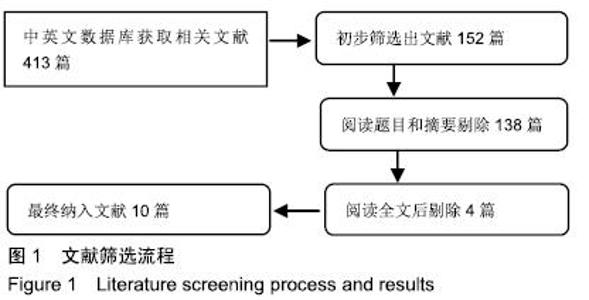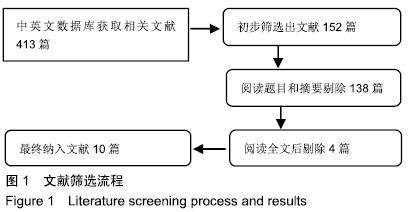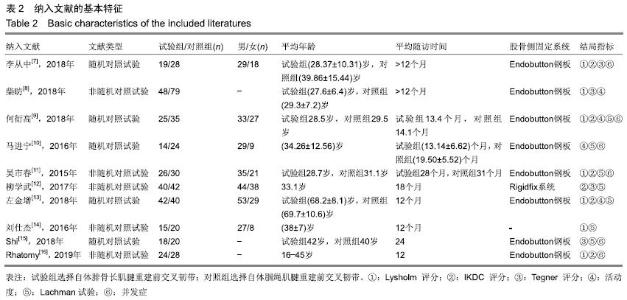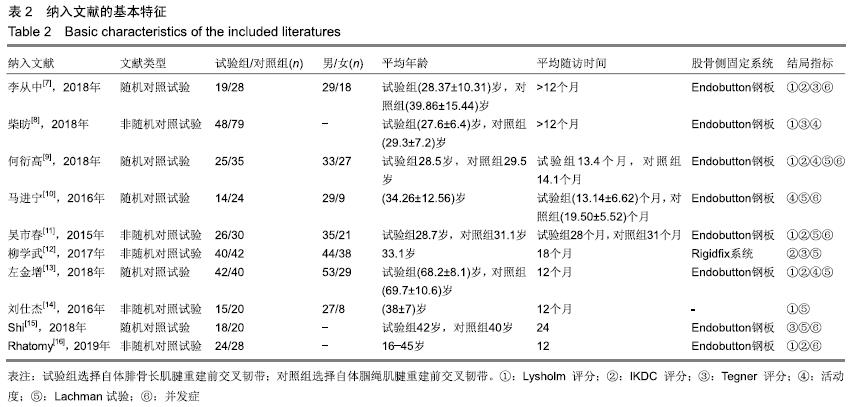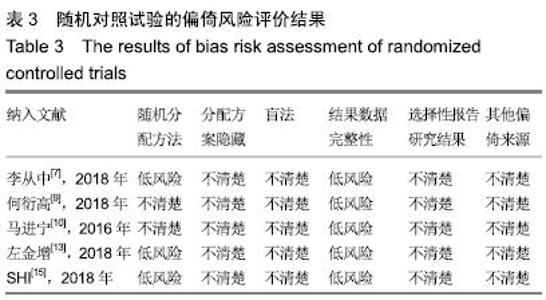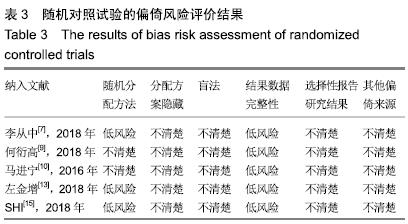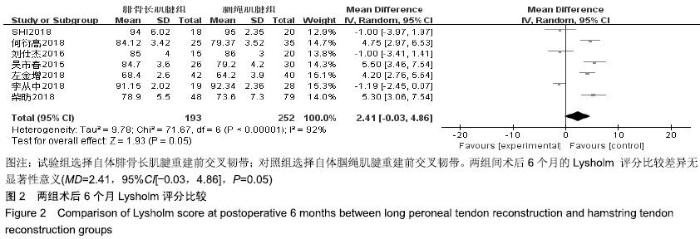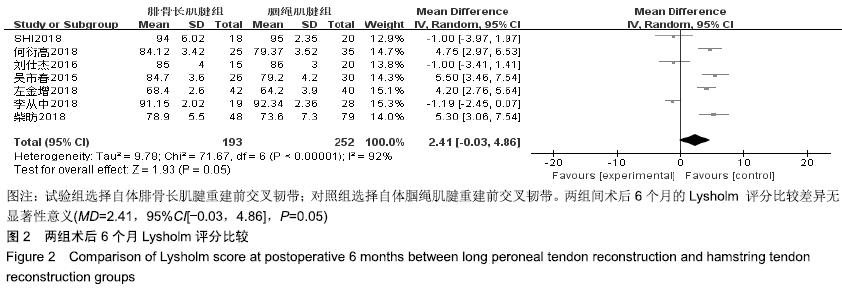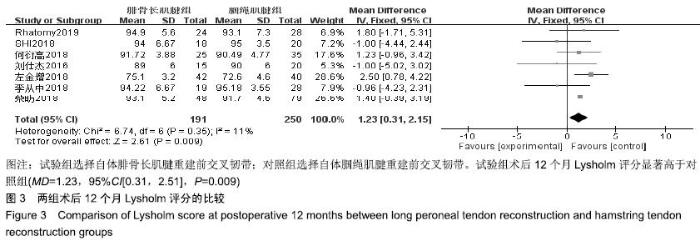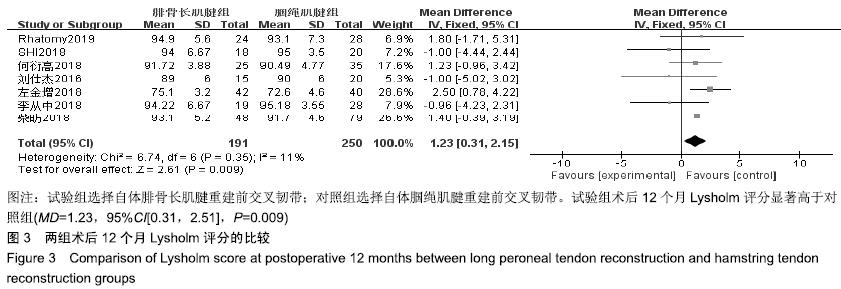Chinese Journal of Tissue Engineering Research ›› 2020, Vol. 24 ›› Issue (5): 811-820.doi: 10.3969/j.issn.2095-4344.1964
Systematic evaluation of anterior cruciate ligament reconstruction with peroneus longus tendon and hamstring tendon
Shi Weifa, Guo Zhimin, Deng Huiyun, Shen Yanling, Shi Lingling, Wu Shilong, Huang Zebin
- Affiliated Southeast Hospital of Xiamen University, Zhangzhou 363200, Fujian Province, China
-
Received:2019-04-19Revised:2019-05-05Accepted:2019-06-12Online:2020-02-18Published:2020-01-15 -
Contact:Guo Zhimin, Associate professor, Master’s supervisor, Associate chief physician, Affiliated Southeast Hospital of Xiamen University, Zhangzhou 363200, Fujian Province, China -
About author:Shi Weifa, Master, Physician, Affiliated Southeast Hospital of Xiamen University, Zhangzhou 363200, Fujian Province, China -
Supported by:Joint Logistic Support System 909 Hospital Youth Nursery Fund, No. 17Y014
CLC Number:
Cite this article
Shi Weifa, Guo Zhimin, Deng Huiyun, Shen Yanling, Shi Lingling, Wu Shilong, Huang Zebin. Systematic evaluation of anterior cruciate ligament reconstruction with peroneus longus tendon and hamstring tendon[J]. Chinese Journal of Tissue Engineering Research, 2020, 24(5): 811-820.
share this article
Add to citation manager EndNote|Reference Manager|ProCite|BibTeX|RefWorks

2.4.5 术后6,12个月关节松弛程度比较 有4个临床研究报道了术后6个月的关节松弛度[10-11,14-15],Meta分析提示各个研究组间Lachman试验Ⅰ度松弛存在同质性(P=0.95,I2=0%),采用固定效应模型,结果显示两组间Lachman试验Ⅰ度松弛比较差异无显著性意义(OR=0.99,95%CI[0.45,2.15],P=0.97),见图10;各个研究组间Lachman试验Ⅱ度以上松弛存在同质性(P=0.56,I2=0%),采用固定效应模型,结果显示两组间Lachman试验Ⅱ度以上松弛比较差异无显著性意义(OR=0.84,95%CI[0.32,2.24],P=0.73),见图11。提示两组间术后6个月关节松弛程度无明显差异。"


有6个临床研究报道术后12个月的关节松弛度[9-10,12-15],Meta分析提示各个研究组间Lachman试验Ⅰ度松弛存在同质性(P=0.77,I2=0%),采用固定效应模型,结果显示两组间Lachman试验Ⅰ度松弛比较差异无显著性意义(OR=1.21,95%CI[0.68,2.14],P=0.52),见图12;各个研究组间Lachman试验Ⅱ度以上松弛存在同质性(P=0.30,I2=17%),采用固定效应模型,结果显示两组间Lachman试验Ⅱ度以上松弛比较差异无显著性意义(OR=0.61,95%CI [0.31,1.23],P=0.17),见图13。上述结果提示两组术后12个月关节松弛度比较无明显差异。"


2.5 敏感性分析与亚组分析 此次Meta分析显示术后6个月的Lysholm评分、术后6,12个月的IKDC评分、术后12个月的Tegner评分、术后12个月的活动度均存在高异质性,其中术后6个月的Lysholm评分、术后6个月的IKDC评分通过逐一剔除文献再行Meta分析,发现异质性仍较高,表明这2个指标结果较为稳健,Meta分析结果可靠。而术后12个月的IKDC评分、术后12个月的活动度通过逐一剔除法发现引起这2指标异质性高来源是左金增[13]文章,考虑异质性高是该文研究对象是老年男性引起,予以剔除该文献,剔除文献后2指标异质性明显降低,见图15,16;术后12个月的Tegner评分同样用剔除法发现异质性来源Shi等[15]的文章,分析其原因是该研究对象均伴有Ⅲ侧韧带损伤,考虑是异质性来源,予以剔除,剔除文献后该指标异质性明显降低,见图17。"

| [1] BICER EK, LUSTIG S, SERVIEN E, et al.Current knowledge in the anatomy of the human anterior cruciate ligament.Knee Surg Sports Traumatol Arthrosc.2010;18(8):1075-1084. [2] SANDERS TL, KREMERS HM, BRYAN AJ, et al.Is Anterior Cruciate Ligament Reconstruction Effective in Preventing Secondary Meniscal Tears and Osteoarthritis? Am J Sports Med.2016;44(7):1699-1707. [3] RAI S, JIN SY, RAI B, et al.A Single Bundle Anterior Cruciate Ligament Reconstruction (ACL-R) Using Hamstring Tendon Autograft and Tibialis Anterior Tendon Allograft: A Comparative Study. Curr Med Sci. 2018;38(5):818-826. [4] GRASSI A, CARULLI C, INNOCENTI M, et al.New Trends in Anterior Cruciate Ligament Reconstruction: A Systematic Review of National Surveys of the Last 5 Years.Joints. 2018; 6(3):177-187. [5] NAZEM K, BARZEGAR M, HOSSEINI A, et al.Can we use peroneus longus in addition to hamstring tendons for anterior cruciate ligament reconstruction? Adv Biomed Res. 2014;3: 115. [6] PIETROSIMONE B, LOESER RF, BLACKBURN JT, et al. Biochemical markers of cartilage metabolism are associated with walking biomechanics 6-months following anterior cruciate ligament reconstruction.J Orthop Res.2017;35(10): 2288-2297. [7] 李从中.自体腓骨长肌腱和腘绳肌腱在关节镜下重建膝关节前交叉韧带临床研究[J].北华大学学报(自然科学版),2018,19(3): 346-349. [8] 柴昉,毕擎.自体腘绳肌腱与部分腓骨长肌腱重建前交叉韧带疗效比较[J].浙江医学,2018,40(14):1570-1573. [9] 何衍高,梁春雨,张德新,等.应用腓骨长肌腱和腘绳肌腱重建前交叉韧带的疗效比较[J].实用骨科杂志, 2018,24(2):185-188. [10] 马进宁,刘勇,王涛,等.取腓骨长肌腱和腘绳肌腱重建前交叉韧带的短期疗效对比研究[J].宁夏医学杂志,2016,38(8):710-712. [11] 吴市春,郑亚才,严康宁,等.腓骨长肌腱与腘绳肌腱重建前交叉韧带的疗效比较[J].中国修复重建外科杂志,2015,29(11): 1358-1363. [12] 柳学武,潘风雨,冯尚祥,等.关节镜下自体腓骨长肌腱与腘绳肌腱重建前交叉韧带比较分析[J].中国伤残医学, 2017,25(14): 5-8. [13] 左金增,史福东.关节镜下腓骨长肌腱重建术治疗老年急性前交叉韧带断裂的疗效研究[J].中国全科医学,2018,21(30): 3718-3722. [14] 刘仕杰,史福东,王雪臣,等.自体腓骨长肌腱和腘绳肌腱重建前交叉韧带术后疗效及移植物磁共振成像形态学变化研究[J].中国医药,2016,11(10):1538-1542. [15] SHI FD, HESS DE, ZUO JZ, et al.Peroneus Longus Tendon Autograft is a Safe and Effective Alternative for Anterior Cruciate Ligament Reconstruction.J Knee Surg.2018.doi: 10.1055/s-0038-1669951.[Epub ahead of print] [16] RHATOMY S, ASIKIN AIZ, WARDANI AE, et al.Peroneus longus autograft can be recommended as a superior graft to hamstring tendon in single-bundle ACL reconstruction. Knee Surg Sports Traumatol Arthrosc 2019.doi: 10.1007/s00167-019-05455-w.[Epub ahead of print] [17] CONTE EJ, HYATT AE, GATT CJ JR, et al.Hamstring autograft size can be predicted and is a potential risk factor for anterior cruciate ligament reconstruction failure. Arthroscopy. 2014; 30(7):882-890. [18] FIGUEROA F, FIGUEROA D, ESPREGUEIRA-MENDES J. Hamstring autograft size importance in anterior cruciate ligament repair surgery.EFORT Open Rev.2018;3:93-97. [19] XIE G, HUANGFU X, ZHAO J.Prediction of the graft size of 4-stranded semitendinosus tendon and 4-stranded gracilis tendon for anterior cruciate ligament reconstruction: a Chinese Han patient study. Am J Sports Med. 2012;40: 1161-1166. [20] FIGUEROA D, CALVO R, VAISMAN A, et al.Injury to the infrapatellar branch of the saphenous nerve in ACL reconstruction with the hamstrings technique: clinical and electrophysiological study.Knee. 2008;15(5):360-363. [21] SANDERS B, ROLF R, MCCLELLAND W, et al.Prevalence of saphenous nerve injury after autogenous hamstring harvest: an anatomic and clinical study of sartorial branch injury. Arthroscopy.2007;23(9):956-963. [22] CRISTIANI R, FORSSBLAD M, ENGSTROM B, et al.Risk Factors for Abnormal Anteroposterior Knee Laxity After Primary Anterior Cruciate Ligament Reconstruction. Arthroscopy. 2018;34(8): 2478-2484. [23] CRISTIANI R, SARAKATSIANOS V, ENGSTROM B, et al. Increased knee laxity with hamstring tendon autograft compared to patellar tendon autograft: a cohort study of 5462 patients with primary anterior cruciate ligament reconstruction.Knee Surg Sports Traumatol Arthrosc.2019; 27:381-388. [24] KIM HS, SEON JK, JO AR. Current trends in anterior cruciate ligament reconstruction. Knee Surg Relat Res. 2013;25:165-173. [25] TSCHOLL PM, HALDEMANN VM, DE SMET A, et al.[How to choose the ideal graft for anterior cruciate ligament reconstruction]. Rev Med Suisse.2017;13(569):1339-1342. [26] PALMER JE, RUSSELL JP, GRIESHOBER J, et al.A Biomechanical Comparison of Allograft Tendons for Ligament Reconstruction. Am J Sports Med.2017;45(3):701-707. [27] ZHAO J, HUANGFU X.The biomechanical and clinical application of using the anterior half of the peroneus longus tendon as an autograft source.Am J Sports Med. 2012;40(3): 662-671. [28] KERIMOGLU S, KOSUCU P, LIVAOĞLU M, et al. Magnetic resonance imagination of the peroneus longus tendon after anterior cruciate ligament reconstruction.Knee Surg Sports Traumatol Arthrosc.2009;1(1):35-39. [29] ANGTHONG C, CHERNCHUJIT B, APIVATGAROON A,et al. The Anterior Cruciate Ligament Reconstruction with the Peroneus Longus Tendon: A Biomechanical and Clinical Evaluation of the Donor Ankle Morbidity.J Med Assoc Thai. 2015;98(6):555-560. |
| [1] | Chen Junming, Yue Chen, He Peilin, Zhang Juntao, Sun Moyuan, Liu Youwen. Hip arthroplasty versus proximal femoral nail antirotation for intertrochanteric fractures in older adults: a meta-analysis [J]. Chinese Journal of Tissue Engineering Research, 2021, 25(9): 1452-1457. |
| [2] | Chen Jinping, Li Kui, Chen Qian, Guo Haoran, Zhang Yingbo, Wei Peng. Meta-analysis of the efficacy and safety of tranexamic acid in open spinal surgery [J]. Chinese Journal of Tissue Engineering Research, 2021, 25(9): 1458-1464. |
| [3] | Hu Kai, Qiao Xiaohong, Zhang Yonghong, Wang Dong, Qin Sihe. Treatment of displaced intra-articular calcaneal fractures with cannulated screws and plates: a meta-analysis of 15 randomized controlled trials [J]. Chinese Journal of Tissue Engineering Research, 2021, 25(9): 1465-1470. |
| [4] | Huang Dengcheng, Wang Zhike, Cao Xuewei. Comparison of the short-term efficacy of extracorporeal shock wave therapy for middle-aged and elderly knee osteoarthritis: a meta-analysis [J]. Chinese Journal of Tissue Engineering Research, 2021, 25(9): 1471-1476. |
| [5] | Wang Yongsheng, Wu Yang, Li Yanchun. Effect of acute high-intensity exercise on appetite hormones in adults: a meta-analysis [J]. Chinese Journal of Tissue Engineering Research, 2021, 25(8): 1305-1312. |
| [6] | Kong Desheng, He Jingjing, Feng Baofeng, Guo Ruiyun, Asiamah Ernest Amponsah, Lü Fei, Zhang Shuhan, Zhang Xiaolin, Ma Jun, Cui Huixian. Efficacy of mesenchymal stem cells in the spinal cord injury of large animal models: a meta-analysis [J]. Chinese Journal of Tissue Engineering Research, 2021, 25(7): 1142-1148. |
| [7] | Huang Dengcheng, Wang Zhike, Cao Xuewei. Intravenous, topical tranexamic acid alone or their combination in total knee arthroplasty: a meta-analysis of randomized controlled trials [J]. Chinese Journal of Tissue Engineering Research, 2021, 25(6): 948-956. |
| [8] | Li Yan, Wang Pei, Deng Donghuan, Yan Wei, Li Lei, Jiang Hongjiang. Electroacupuncture for pain control after total knee arthroplasty: a meta-analysis [J]. Chinese Journal of Tissue Engineering Research, 2021, 25(6): 957-963. |
| [9] | He Xiangzhong, Chen Haiyun, Liu Jun, Lü Yang, Pan Jianke, Yang Wenbin, He Jingwen, Huang Junhan. Platelet-rich plasma combined with microfracture versus microfracture in the treatment of knee cartilage lesions: a meta-analysis [J]. Chinese Journal of Tissue Engineering Research, 2021, 25(6): 964-969. |
| [10] | Hua Haotian, Zhao Wenyu, Zhang Lei, Bai Wenbo, Wang Xinwei. Meta-analysis of clinical efficacy and safety of antibiotic artificial bone in the treatment of chronic osteomyelitis [J]. Chinese Journal of Tissue Engineering Research, 2021, 25(6): 970-976. |
| [11] | Zhan Fangbiao, Cheng Jun, Zou Xinsen, Long Jie, Xie Lizhong, Deng Qianrong. Intraoperative intravenous application of tranexamic acid reduces perioperative bleeding in multilevel posterior spinal surgery: a meta-analysis [J]. Chinese Journal of Tissue Engineering Research, 2021, 25(6): 977-984. |
| [12] | Zhong Yuanming, Wan Tong, Zhong Xifeng, Wu Zhuotan, He Bingkun, Wu Sixian. Meta-analysis of the efficacy and safety of percutaneous curved vertebroplasty and unilateral pedicle approach percutaneous vertebroplasty in the treatment of osteoporotic vertebral compression fracture [J]. Chinese Journal of Tissue Engineering Research, 2021, 25(3): 456-462. |
| [13] | Li Yang, Zhang Mingyong. Meta-analysis of the effect of double Endobutton and clavicular hook plate on the treatment of acromioclavicular dislocation [J]. Chinese Journal of Tissue Engineering Research, 2021, 25(3): 463-470. |
| [14] | Li Yanle, Yue Xiaohua, Wang Pei, Nie Weizhi, Zhang Junwei, Tan Yonghai, Jiang Hongjiang. Intramedullary nail fixation versus plate fixation in the treatment of displaced midshaft clavicular fractures in adults: a meta-analysis [J]. Chinese Journal of Tissue Engineering Research, 2021, 25(3): 471-476. |
| [15] | Liu Chang, Han Shufeng. Interlocking intramedullary nail for proximal femur versus proximal femoral anti-rotation intramedullary nail or proximal femoral anti-rotation intramedullary nail of Asian for intertrochanteric fractures in older adults: a meta-analysis [J]. Chinese Journal of Tissue Engineering Research, 2021, 25(3): 477-485. |
| Viewed | ||||||
|
Full text |
|
|||||
|
Abstract |
|
|||||
